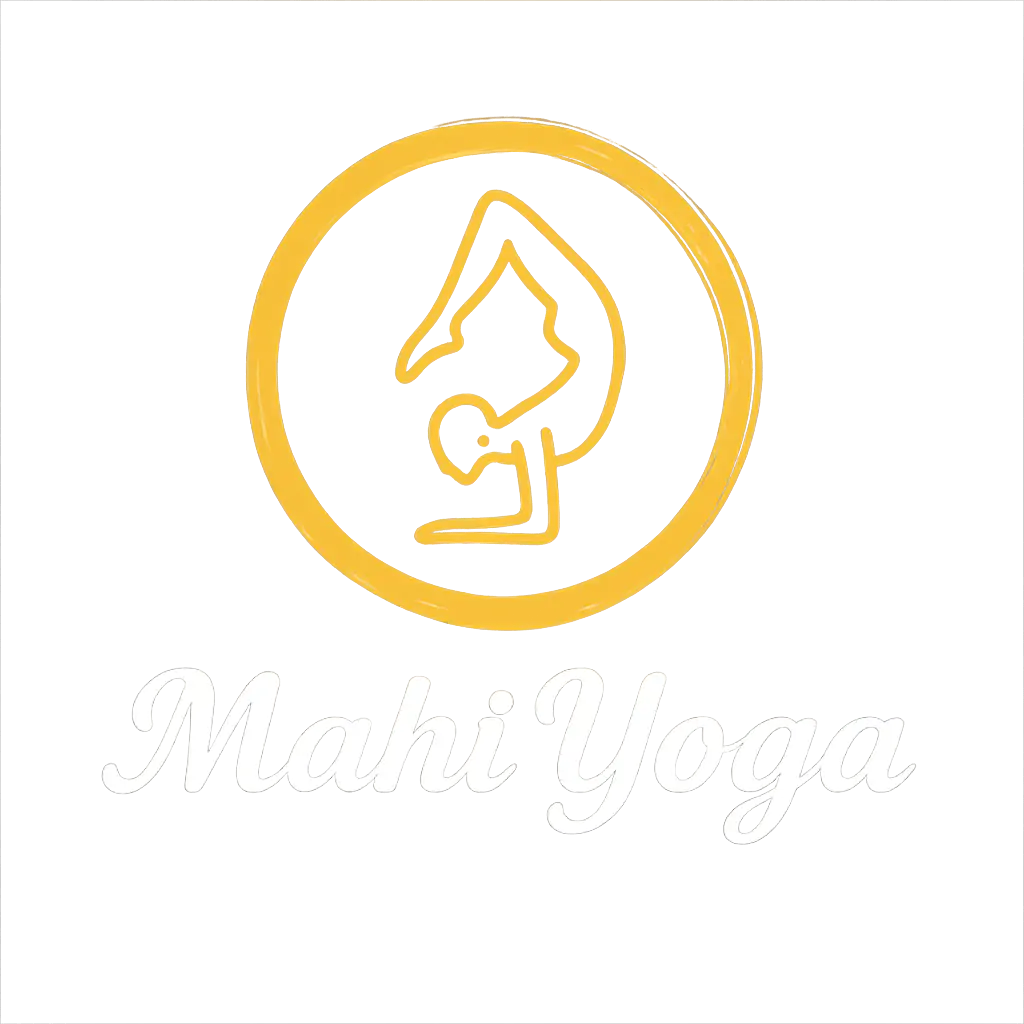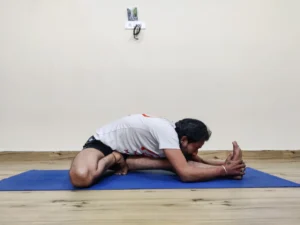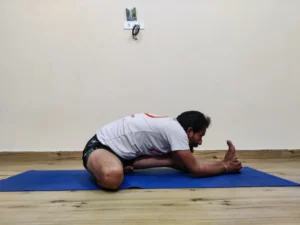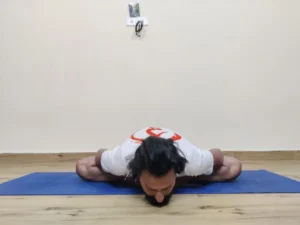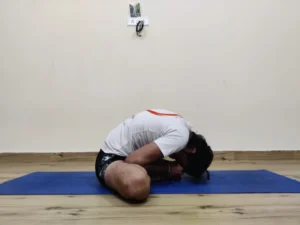SITTING POSTURES: UNVEILING THE INNER LANDSCAPE IN ASHTANGA YOGA
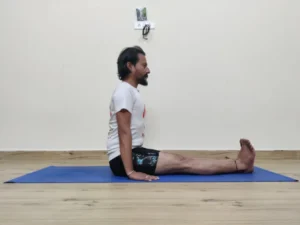
1. DANDASANA – STAFF POSTURE:-
Sanskrit Name: दण्डासन (Daṇḍāsana)
Meaning: “Staff posture” (Daṇḍa = staff, asana = posture)
Dandasana, or Staff Pose, in Hatha Yoga, aligns the spine like a staff, strengthening the lower back, abdomen, and pelvis. Enhances posture and establishes a strong foundation for overall spinal health

2. PASCHIMOTTANASANA (A-D)– SITTING FORWARD BEND(A-D) :-
Sanskrit Name: पश्चिमोत्तानासन (Paschimottanāsana)
Meaning: “West-stretching posture” (Paschima = west, uttana = intense stretching, asana = posture)
Paschimottanasana, also known as the Seated Forward Bend, is a fundamental seated forward bend posture widely practiced in Hatha yoga. It offers a deep stretch to the hamstrings, spine, and shoulders, providing numerous physical and mental benefits.
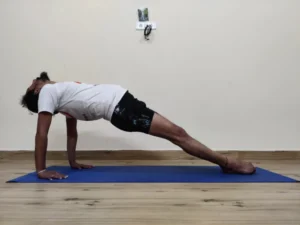
3. PURVOTTANASANA – INTENSE EAST STRETCH :-
Sanskrit Name: पुरवोत्तानासन (Purvottanāsana)
Meaning: “East-stretching posture” (Purva = east, uttana = intense stretching, asana = posture)
Purvottanasana, also known as Upward Plank Pose, lives up to its name by providing an intense stretch to the front of the body in an elegant backbend. It’s a powerful posture offering numerous benefits, but demands proper technique and awareness to practice safely.
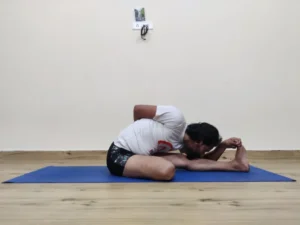
4. Ardha Baddha Padma Paschimottanasana – Half Bound Lotus Forward Bend
Sanskrit Name: अर्ध बद्ध पद्म पश्चिमोत्तानासन (Ardha Baddha Padma Paścimottanāsana)
Meaning: “Half-bound lotus, west-stretching posture” (Ardha = half, baddha = bound, padma = lotus, paschima = west, uttana = intense stretching, asana = posture)
Ardha Baddha Padma Paschimottanasana, also known as Half Bound Lotus Forward Bend, is an intermediate-level posture combining a seated forward bend with a half lotus leg position. It offers a deep stretch to the hamstrings, spine, hips, and shoulders, along with several other benefits.
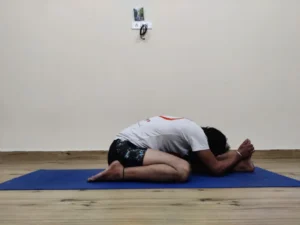
5. Trianga Mukhaikapada Paschimottanasana – Three Limbs Facing One Foot Forward Bend
Sanskrit Name: त्रिङ्ग मुखैकपाद पश्चिमोत्तानासन (Triṃga Mukhaikapada Paścimottanāsana)
Meaning: “Three limbs, face-to-one-foot, west-stretching posture” (Triṃga = three limbs, mukha = face, eka = one, pāda = foot, paschima = west, uttana = intense stretching, asana = posture)
Trianga Mukhaikapada Paschimottanasana, also known as One-Leg Folded Forward Bend, is a challenging advanced seated forward bend posture requiring balance, flexibility, and core strength. It engages three areas – feet, knees, and buttocks – hence the name “Trianga” (three limbs).
6. JANU SIRSH ASANA (A-C) – HEAD TO KNEE POSTURE (A-C)
Sanskrit Name: जानु शीर्षासन (Jānu Śīrṣāsana)
Janu Sirsasana, also known as Head to Knee Pose, is a gentle to intermediate seated forward bend posture offered in three variations (A-C). It provides a deep stretch to the hamstrings, spine, and hips, promoting calmness and improving flexibility.
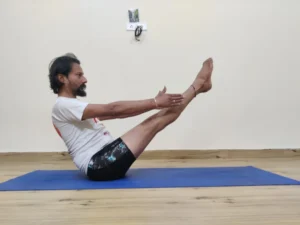
7. NAVASANA – BOAT POSTURE
Sanskrit Name: नवासन (Navāsana)
Meaning: “Boat posture” (Nava = boat,
Navasana, also known as Boat Pose, is a fundamental intermediate balancing posture in Hatha yoga. It resembles a boat floating on water, hence its name, and requires both core strength and balance to hold effectively.
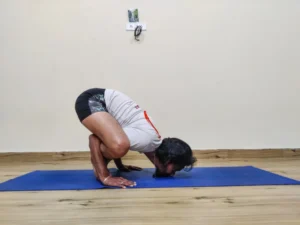
8. BHUJAPIDASANA • SHOULDER PRESSURE POSTURE
Sanskrit Name: भुजपीडासन (Bhujapīḍāsana)
Meaning: “Shoulder pressure posture” (Bhuja = arm, pīḍa = pressure, asana = posture)
Bhujapidasana, also known as Shoulder Pressure Pose, is an advanced arm balance posture in Hatha yoga. It resembles a human pretzel, demanding significant flexibility, strength, and balance to master.

10. GARBHA PINDASANA • EMBRYO POSTURE
Sanskrit Name: गर्भ पिंडासन (Garbha Piṇḍāsana)
Meaning: “Embryo posture” (Garbha = womb, Piṇḍa = fetus, asana = posture)
Garbha Pindasana, also known as Embryo Pose, is a seated forward bend posture in Hatha yoga. It mimics the position of a fetus in the womb, offering a sense of comfort, security, and deep relaxation.
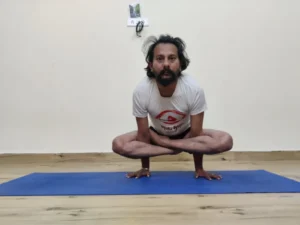
11. KUKKUTASANA • ROOSTER POSTURE
Sanskrit Name: कुक्कुटासन (Kukkuṭāsana)
Meaning: “Rooster posture” (Kukkuṭa = rooster,
Kukkutasana, also known as Rooster Pose, is an advanced arm-balancing asana in Hatha yoga. It requires significant strength, flexibility, and balance to hold successfully, resembling a rooster standing tall on its feet.
12. BADDHA KONASANA A-B • BOUND ANGLE POSTURE
Sanskrit Name: बद्धकोणासन (baddhakoṇāsana)
Meaning: The name comes from the Sanskrit words:
- बद्ध (baddha):meaning “bound,” “tied,” or “knotted”
- कोण (koṇa):meaning “angle” or “corner”
- आसन (āsana):meaning “posture” or “seat”
Baddha Konasana, also known as Cobbler’s Pose, is a seated posture that offers a gentle yet effective stretch for the inner thighs and hips. It’s often considered a beginner-friendly pose, but variations provide deeper challenges for more experienced practitioners.
13. UPAVISTA KONASANA A-B • SEATED ANGLE POSTURE
Sanskrit Name: उपविष्ठ कोणासन (upaviṣṭha koṇāsana)
Meaning: The name breaks down into the following Sanskrit words:
- उपविष्ठ (upaviṣṭha):meaning “seated” or “sitting”
- कोण (koṇa):meaning “angle” or “corner”
- आसन (āsana):meaning “posture” or “seat”
Upavistha Konasana, also known as Wide-Angle Seated Forward Bend, is a seated posture requiring flexibility and offering a deep stretch for the hamstrings, back, and inner thighs. It comes in two variations (A & B) targeting different aspects of the stretch.

14. SUPTA KONASANA A-B • LYING-DOWN ANGLE POSTURE
Sanskrit Names:
- Supta Konasana A: सुप्तकोणासन (Supta-koṇa-āsana)
Meaning Breakdown:
- Supta (सुप्त): Reclining, sleeping
- Koṇa (कोण): Angle, corner
- Āsana (आसन): Posture, seat
Supta Konasana, also known as Reclined Angle Pose, is a yoga posture with two variations often referred to as “A” and “B.” Both variations target the inner thighs (adductors) and hamstrings, but with slightly different emphasis.

15. SUPTA PADANGUSTASANA • RECLINING BIG TOE POSTURE
Supta Padangusthasana (शयनाङ्गुष्ठासन), also known as Reclining Big Toe Pose, offers a multifaceted experience for yogis of all levels. Its Sanskrit name breaks down as follows:
- शयना (śayana):meaning “lying down” or “reclining”
- ङ्गुष्ठ (aṅguṣṭha):meaning “big toe” or “thumb”
- आसन (āsana):meaning “posture” or “seat”
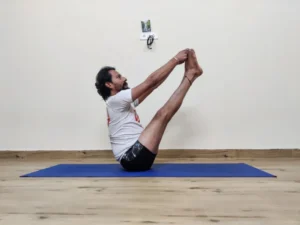
16. UBHAYA PADANGUSTHASANA • BOTH BIG TOES POSTURE
Ubhaya Padangusthasana, also known as Double Toe Hold Pose, is a dynamic posture in yoga that challenges your core strength and balance while offering benefits for various body parts. Here’s a brief introduction:
Sanskrit Name and Meaning:
- उभय (ubhaya):meaning “both”
- पाद (pāda):meaning “foot”
- अङ्गुष्ठ (aṅguṣṭha):meaning “big toe”
- आसन (āsana):meaning “posture” or “seat”
So, the name translates to “Both Big Toes Posture,” accurately reflecting the position you hold in the pose.

17. UBHAYA PADANGUSTHASANA • BOTH BIG TOES POSTURE
Ubhaya Padangusthasana, also known as Double Toe Hold Pose, is a dynamic posture in yoga that challenges your core strength and balance while offering benefits for various body parts. Here’s a brief introduction:
Sanskrit Name and Meaning:
- उभय (ubhaya):meaning “both”
- पाद (pāda):meaning “foot”
- अङ्गुष्ठ (aṅguṣṭha):meaning “big toe”
- आसन (āsana):meaning “posture” or “seat”
So, the name translates to “Both Big Toes Posture,” accurately reflecting the position you hold in the pose.

18. Urdhva Mukha Paschimottasana-Upward Facing Full Forward Bend
This known pose, also called Upward-Facing Seated Forward Bend or Upward-Facing Forward Fold, involves sitting with legs together, reaching forward to bend and grab your feet, then lifting your torso while keeping your legs straight. It’s an advanced forward bend and requires flexibility and core strength.
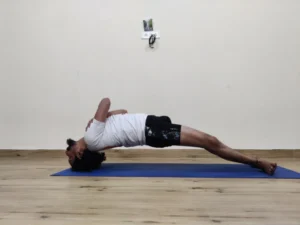
19. SETU BANDHASANA • BRIDGE
Setu Bandhasana, also known as Bridge Pose, is a versatile yoga posture commonly practiced for its numerous benefits. Here’s a brief introduction:
Sanskrit Name & Meaning:
- Setu (सेतु):meaning “bridge”
- Bandha (बंध):meaning “lock” or “bind”
- Asana (आसन):meaning “posture” or “seat”
Therefore, the combined meaning translates to “Bridge Posture,” accurately reflecting the shape formed by your body in the pose.
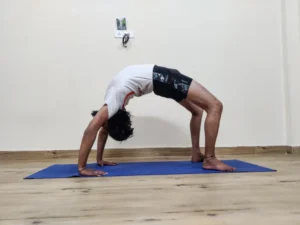
20. Urdhva Dhanurasana • Upward Bow Posture
Urdhva Dhanurasana, also known as Upward Bow Pose or Wheel Pose, is a challenging yet rewarding backbend posture in yoga. Here’s a brief introduction:
Sanskrit Name and Meaning:
- Urdhva (उर्ध्व):meaning “upward”
- Dhanu (धनु):meaning “bow”
- Asana (आसन):meaning “posture” or “seat”
So, the combined meaning translates to “Upward Bow Posture,” reflecting the body’s shape resembling a bent bow facing upwards.
